This Bao Buns Recipe is enjoyed for their soft, pillowy texture, flavorful fillings, and the delightful contrast of textures and flavors in each bite.
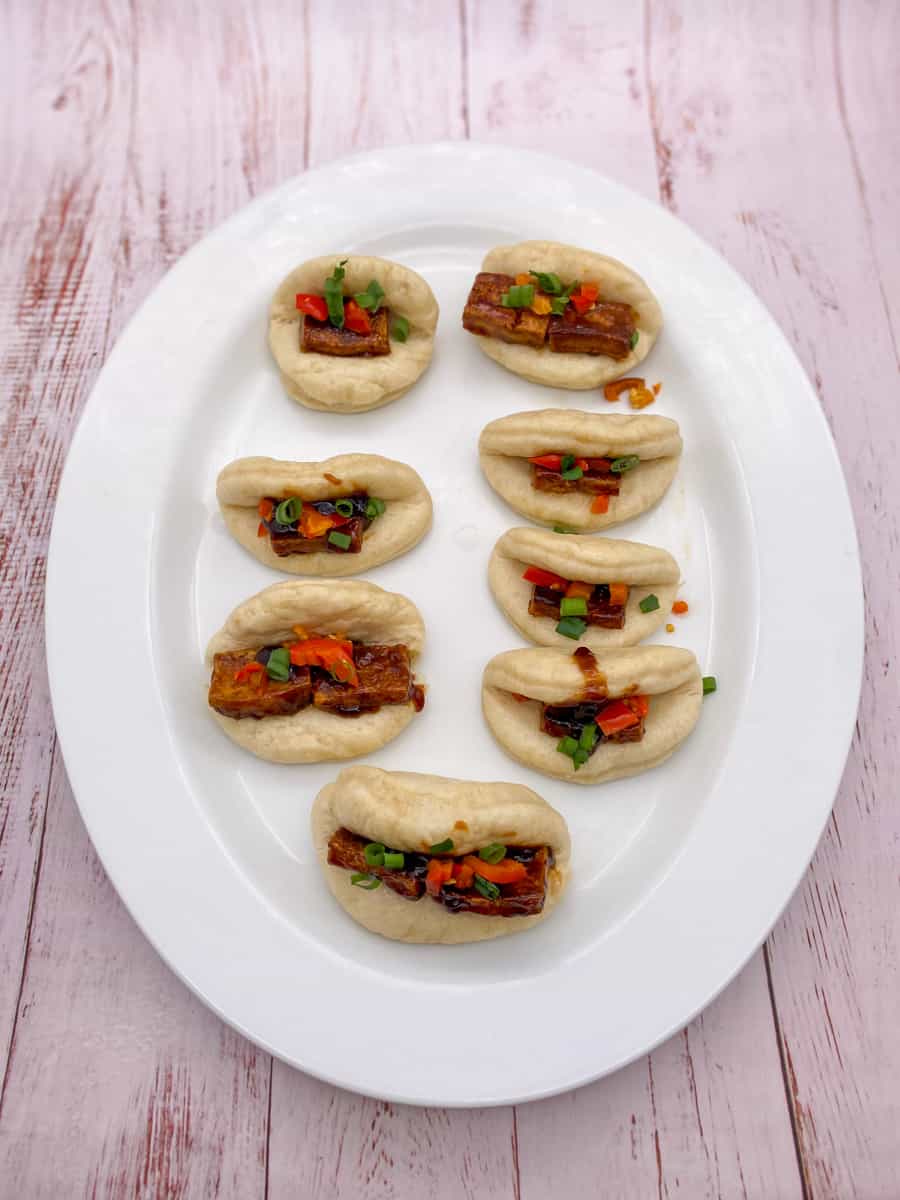
Bao buns, also known as steamed buns or baozi, are a popular Chinese street food that has gained global popularity. These fluffy and pillowy buns are typically filled with a variety of savory ingredients and are a delight to bite into. The buns are steamed to perfection, resulting in a soft and slightly chewy texture that pairs wonderfully with the flavorful fillings.
Whether you prefer traditional pork filling, vegetarian options, or creative variations, bao buns offer a delicious and satisfying culinary experience. In this recipe, we will guide you through the process of making homemade bao buns from scratch, allowing you to enjoy these delectable treats right in your own kitchen. Get ready to experience the joy of making and savoring these delightful Asian buns.
Serve these buns alongside of my Sesame Tofu or my Szechuan Green Beans Recipe.
Jump to:
What are Bao Buns?
Bao buns, also known as steamed buns or baozi, are a type of Chinese bread-like bun that is steamed instead of baked. They are made with a soft and fluffy dough that yields a light and airy texture. Bao buns are typically filled with various savory fillings, making them a popular street food and dim sum item in Chinese cuisine.
The buns are characterized by their distinct shape, which is round and slightly flattened. They have a smooth and shiny surface that is often white in color, although some variations may be tinted with natural food coloring. Bao buns can vary in size, but they are typically small enough to be held in one hand.
Why are Bao Buns so great?
- Soft and Fluffy Texture: Bao buns have a unique texture that is soft, pillowy, and slightly chewy. The dough is made using yeast, which gives the buns a light and airy consistency. The contrast between the soft bun and the filling creates a delightful mouthfeel.
- Versatile Fillings: Bao buns can be filled with a wide variety of ingredients, allowing for endless flavor combinations. Popular fillings include succulent meats like barbecued pork or braised beef, marinated tofu, crispy fried chicken, or even combinations of vegetables and sauces. The versatility of fillings makes bao buns suitable for different dietary preferences and tastes.
- Balanced Flavors: Bao buns typically feature a combination of savory, sweet, and tangy flavors. The fillings are often seasoned with flavorful sauces, spices, and herbs, creating a harmonious blend of tastes. The balance of flavors in bao buns adds depth and complexity to each bite.
Bao Buns Recipe Ingredients
You'll only need a few simple ingredients to make this Bao Buns Recipe. The exact measurements are listed in the recipe card below. Here's an overview of what you'll need:
- Water
- Milk
- Active dry yeast
- Sugar
- Vegetable oil
- All purpose flour
- Baking powder
See recipe card for quantities.
How to make Bao Buns

Activate the yeast. Add the warm water and warm milk in a small bowl. Make sure it is not hot when you touch it but warm to the touch. Add the yeast, oil and sugar. Stir and let it sit for 4 minutes.

Create the dough. In a stand mixer, add the flour, baking powder and salt. Using a dough hook, mix until combined. Slowly add in the wet ingredients and knead for 3-5 minutes on medium speed. Rise the dough. Let the dough sit in a bowl and cover with cling wrap for 2 hours, or until the dough has doubled in size.

Form the buns. You will not need to add more flour like you do with pasta. With a rolling pin, roll out the dough until ⅓ inch thick. With a glass, cup, or round cookie cutter, cut through the dough to form perfect circles and repeat with the rest of the dough. Pull out the dough you won’t use and repeat the same process until you are left with little or no dough. Lightly brush vegetable oil on the circles and fold in half like a half moon. Press down with your hand so it stays folded. They might fold back out into a circle – those might need extra pressure! Let them rest for another 30 minutes.

Steam the buns. Meanwhile in a wok or steamer, bring water to a boil. If you have a bamboo steamer, use that. If you don’t: Cut parchment paper into squares the size of your buns. Spray the squares with nonstick cooking spray and place the buns on them and on the steamer. Wrap the lid with a tea towel and, with a rubber band, tie the towel around the handle. Steam the buns for 8 to 12 minutes, depending on the thickness of your dough. Repeat with the rest of the buns. Tip: While you’re steaming the rest of your buns, you can wrap the steamed ones in a clean towel to keep them warm.
Notes
- If you use instant yeast, be sure to use 2 ¼ teaspoons and rise time will only be around 30 minutes or until it doubles in size.
- I highly recommend testing the yeast for activity before starting to work on this recipe. Add 1 teaspoon of sugar and 2 ¼ teaspoons of yeast (one envelope) to ¼ cup of warm water. Wait for 10 minutes and if you see foams and bubbles and you smell that yeast aroma, your yeast is still good to go. If not, then you need to get fresh yeast.
Bao Buns Recipe Variations
- Char Siu Bao: This classic variation features tender and juicy char siu, which is Chinese barbecue pork, as the filling. The pork is marinated in a sweet and savory sauce, creating a delicious contrast with the soft bun.
- Vegetarian/Vegan Bao: For a plant-based option, you can fill the buns with a variety of vegetarian or vegan fillings. Popular choices include marinated tofu, sautéed vegetables, braised mushrooms, or even a combination of different veggies for a colorful and flavorful filling.
- Teriyaki Chicken Bao: Marinated and grilled teriyaki chicken is a flavorful filling option that adds a touch of sweetness and umami to the buns. Top it with some fresh lettuce or cucumber slices for added crunch.
- Fill these buns with my Honey Garlic Sticky Shrimp.

Equipment
If you don't have a bamboo steamer, you can still make bao buns using alternative equipment. Here's a list of equipment you can use as a substitute:
- Large Pot with Lid: A large pot with a tight-fitting lid can be used as a makeshift steamer. Fill the pot with a few inches of water and place a heatproof plate or a small metal rack inside the pot to elevate the bao buns. Make sure the plate or rack is sturdy and can withstand the heat.
- Metal Colander: A metal colander can be used as an alternative steaming vessel. Place the colander over a pot of simmering water, ensuring that the colander sits securely and does not touch the water. Cover the colander with a lid or a heatproof plate to trap the steam. Use parchment paper to place bao buns on top so they do not stick.
- Heatproof Plate or Pie Dish: Place a heatproof plate or pie dish inside a large pot with a tight-fitting lid. Add a small amount of water to the pot, making sure it doesn't touch the plate. The plate will act as a platform to hold the bao buns.
- Silicone Steamer Inserts: Silicone steamer inserts are flexible and can be used in various pots and pans. They have perforations to allow steam to circulate and cook the bao buns. Place the silicone steamer insert in a pot with a lid, ensuring that it fits securely.
How to store Bao Buns
To store bao buns properly and maintain their freshness, follow these steps:
- Cool the Buns: Allow the bao buns to cool completely after steaming or cooking. This prevents condensation from forming inside the storage container, which can make the buns soggy.
- Choose Appropriate Storage Containers: Use airtight containers or resealable plastic bags to store the bao buns. Make sure the containers are clean and food-safe.
- Separate Layers: Place a sheet of parchment paper or wax paper between each layer of bao buns to prevent them from sticking together.
- Store at Room Temperature: If you plan to consume the buns within the next day or two, you can store them at room temperature. Place the buns in the airtight container and keep them in a cool, dry place away from direct sunlight.
- Refrigeration: If you want to store the buns for a longer period, refrigeration is recommended. Place the bao buns in an airtight container or sealable plastic bag and store them in the refrigerator. They can typically be refrigerated for up to 3 to 4 days.
- Freezing: For longer-term storage, you can freeze the bao buns. Wrap each bun individually in plastic wrap or place them in separate freezer bags. Make sure to remove as much air as possible to prevent freezer burn. Frozen bao buns can be stored for up to 2 to 3 months.
- Thawing and Reheating: When ready to eat, thaw frozen bao buns in the refrigerator overnight. To reheat, you can steam the buns again for a few minutes until they are warmed through. Alternatively, you can wrap the buns in a damp paper towel and microwave them in short intervals until they are heated to your desired temperature.

Bao Buns Recipe Top tips
- Proper Yeast Activation: Make sure to activate the yeast properly by using warm water or milk and a pinch of sugar. The liquid should be around 110°F (43°C) to activate the yeast without killing it. Let the yeast mixture sit for a few minutes until it becomes frothy before adding it to the dough.
- Kneading the Dough: Kneading the dough is crucial to develop gluten and achieve the desired texture of the buns. Knead the dough until it becomes smooth, elastic, and slightly tacky. This may take about 8-10 minutes of kneading.
- Resting and Proofing: Allow the dough to rest and rise in a warm and draft-free area until it doubles in size. This step is essential for the buns to become light and fluffy. Cover the dough with a damp cloth or plastic wrap to prevent it from drying out.
- Shaping the Buns: When shaping the bao buns, roll out the dough into a long cylinder shape and cut it into equal-sized portions. Use a rolling pin to flatten each portion into a round disc, leaving the center slightly thicker than the edges. This will ensure that the buns have a puffy and well-formed shape after steaming.
- Proper Filling-to-Dough Ratio: Be mindful of the filling-to-dough ratio when adding the filling to the buns. Overstuffing can make it challenging to seal the buns properly, while too little filling may result in bland buns. Aim for a balanced amount of filling that can be easily enclosed within the dough.
- Steaming Technique: When steaming the bao buns, make sure to use a steamer lined with parchment paper or cabbage leaves to prevent sticking. Space the buns apart, as they will expand during steaming. Place the steamer over boiling water and steam the buns for the recommended time to achieve the desired texture.
- Avoid Opening the Steamer Lid: While steaming the bao buns, avoid opening the steamer lid during the first few minutes. This can cause temperature fluctuations and affect the steaming process, leading to unevenly cooked buns.
- Enjoy Freshly Steamed Buns: Bao buns are best enjoyed fresh and warm. Serve them immediately after steaming to savor their fluffy texture and aromatic filling. If you need to store or reheat the buns, follow the storage tips mentioned earlier.

Bao Buns without Bamboo Steamer
- Total Time: 2 Hours 42 minutes
- Yield: 4 servings 1x
Description
This is how to make light, fluffy and soft bao buns without steamer using water, milk, yeast, oil, flour and baking powder.
Ingredients
- ⅓ cup warm water
- ½ cup warm milk
- 1 tablespoons active dry yeast
- 2 tablespoons sugar
- 2 tablespoons vegetable oil
- 2 ½ cups all purpose flour
- ½ teaspoon baking powder
- ¼ teaspoon salt
Instructions
- Activate the yeast. Add the warm water and warm milk in a small bowl. Make sure it is not hot when you touch it but warm to the touch. Add the yeast, oil and sugar. Stir and let it sit for 4 minutes.
- Create the dough. In a stand mixer, add the flour, baking powder and salt. Using a dough hook, mix until combined. Slowly add in the wet ingredients and knead for 3-5 minutes on medium speed.
- Rise the dough. Let the dough sit in a bowl and cover with cling wrap for 2 hours, or until the dough has doubled in size.
- Form the buns. You will not need to add more flour like you do with pasta. With a rolling pin, roll out the dough until ⅓ inch thick. With a glass, cup, or round cookie cutter, cut through the dough to form perfect circles and repeat with the rest of the dough. Pull out the dough you won’t use and repeat the same process until you are left with little or no dough.
- Form the buns. Lightly brush vegetable oil on the circles and fold in half like a half moon. Press down with your hand so it stays folded. They might fold back out into a circle – those might need extra pressure! Let them rest for another 30 minutes.
- Steam the buns. Meanwhile in a wok or steamer, bring water to a boil. If you have a bamboo steamer, use that. If you don’t: Cut parchment paper into squares the size of your buns. Spray the squares with nonstick cooking spray and place the buns on them and on the steamer. Wrap the lid with a tea towel and, with a rubber band, tie the towel around the handle. Steam the buns for 8 to 12 minutes, depending on the thickness of your dough. Repeat with the rest of the buns. Tip: While you’re steaming the rest of your buns, you can wrap the steamed ones in a clean towel to keep them warm.
Notes
- If you use instant yeast, be sure to use 2 ¼ teaspoons and rise time will only be around 30 minutes or until it doubles in size.
- I highly recommend testing the yeast for activity before starting to work on this recipe. Add 1 teaspoon of sugar and 2 ¼ teaspoons of yeast (one envelope) to ¼ cup of warm water. Wait for 10 minutes and if you see foams and bubbles and you smell that yeast aroma, your yeast is still good to go. If not, then you need to get fresh yeast.
-
Proper Yeast Activation: Make sure to activate the yeast properly by using warm water or milk and a pinch of sugar. The liquid should be around 110°F (43°C) to activate the yeast without killing it. Let the yeast mixture sit for a few minutes until it becomes frothy before adding it to the dough.
-
Kneading the Dough: Kneading the dough is crucial to develop gluten and achieve the desired texture of the buns. Knead the dough until it becomes smooth, elastic, and slightly tacky. This may take about 8-10 minutes of kneading.
-
Resting and Proofing: Allow the dough to rest and rise in a warm and draft-free area until it doubles in size. This step is essential for the buns to become light and fluffy. Cover the dough with a damp cloth or plastic wrap to prevent it from drying out.
-
Shaping the Buns: When shaping the bao buns, roll out the dough into a long cylinder shape and cut it into equal-sized portions. Use a rolling pin to flatten each portion into a round disc, leaving the center slightly thicker than the edges. This will ensure that the buns have a puffy and well-formed shape after steaming.
-
Proper Filling-to-Dough Ratio: Be mindful of the filling-to-dough ratio when adding the filling to the buns. Overstuffing can make it challenging to seal the buns properly, while too little filling may result in bland buns. Aim for a balanced amount of filling that can be easily enclosed within the dough.
-
Steaming Technique: When steaming the bao buns, make sure to use a steamer lined with parchment paper or cabbage leaves to prevent sticking. Space the buns apart, as they will expand during steaming. Place the steamer over boiling water and steam the buns for the recommended time to achieve the desired texture.
-
Avoid Opening the Steamer Lid: While steaming the bao buns, avoid opening the steamer lid during the first few minutes. This can cause temperature fluctuations and affect the steaming process, leading to unevenly cooked buns.
-
Enjoy Freshly Steamed Buns: Bao buns are best enjoyed fresh and warm. Serve them immediately after steaming to savor their fluffy texture and aromatic filling. If you need to store or reheat the buns, follow the storage tips mentioned earlier.
- Prep Time: 2 Hours 30 minutes
- Cook Time: 12 minutes
- Category: Dinner
- Method: Steaming
- Cuisine: Chinese
Nutrition
- Serving Size: 1
- Calories: 96.9
- Sugar: 2.5 g
- Sodium: 90.0 mg
- Fat: 2.5 g
- Saturated Fat: 1.7 g
- Carbohydrates: 16.6 g
- Fiber: 0.6 g
- Protein: 1.9 g
- Cholesterol: 0.0 mg
Food safety
- Cook to a minimum temperature of 165 °F (74 °C)
- Do not use the same utensils on cooked food, that previously touched raw meat
- Wash hands after touching raw meat
- Don't leave food sitting out at room temperature for extended periods
- Never leave cooking food unattended
- Use oils with high smoking point to avoid harmful compounds
- Always have good ventilation when using a gas stove



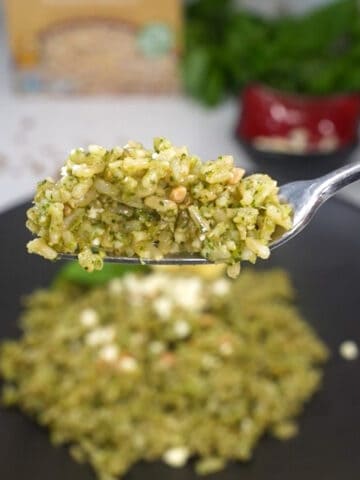
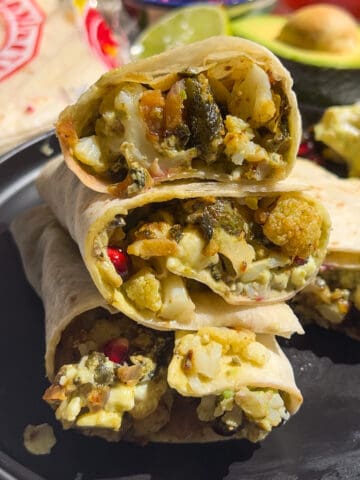
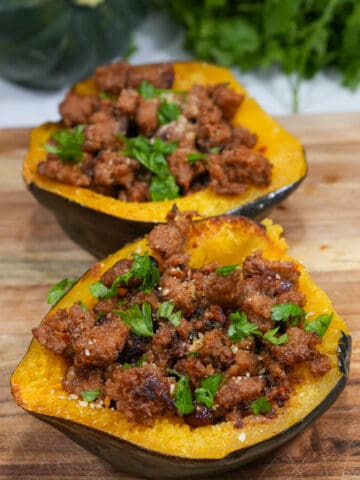
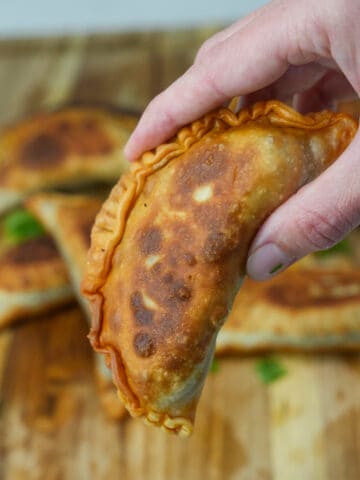

Paulina RBS
SO good!!!
Maxine Dubois
Thanks!
Sarah K
This was so helpful because I don't have a bamboo steamer. Thank you so much.
Lee Poland
How many bao buns does this make?
Maxine Dubois
This will make between 12-14 bao buns.